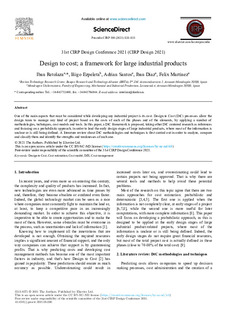| dc.rights.license | Attribution-NonCommercial-NoDerivatives 4.0 International | * |
| dc.contributor.author | Ezpeleta, Iñigo | |
| dc.contributor.other | Retolaza Ojanguren, Iban | |
| dc.contributor.other | Santos Larrauri, Adrián | |
| dc.contributor.other | Martínez Noguera, Félix | |
| dc.date.accessioned | 2021-07-12T09:34:08Z | |
| dc.date.available | 2021-07-12T09:34:08Z | |
| dc.date.issued | 2021 | |
| dc.identifier.issn | 2212-8271 | en |
| dc.identifier.other | https://katalogoa.mondragon.edu/janium-bin/janium_login_opac.pl?find&ficha_no=164329 | en |
| dc.identifier.uri | https://hdl.handle.net/20.500.11984/5337 | |
| dc.description.abstract | A literature review on the assembly design methodologies (DfA) oriented to the assembly of large and heavy parts, reveals the need to develop a DfA methodology. In addition, the lack of DfA evaluation methods for on-site assembly is also observed. The most widespread DfA methodologies are more oriented toward the improvement of factory assembly processes, where the assembly processes are well defined and standardised. Hence, this article presents a new methodology for the design of assemblies with large and heavy parts on site, called OSIA (On-Site Installation Analysis). OSIA methodology aims to provide data (indicators). On the one hand the theoretical basis of the OSIA methodology is based on three key concepts: i) analysis of assembly operations similar to the one used by the SMED methodology; ii) generic implementation process of DfA methodologies; and, iii) compilation of assembly operation times and estimation of standard times per operation. On the other hand, the steps in the implementation of the methodology are summarized in: i) database development with assembly operations and standard times; ii) assembly operations analysis; iii) calculation of assembly time; and iv) product optimization. In this way, OSIA methodology supports the designer in the specification phase, detailed design phase and in the redesign processes, providing the designer with indicators that make it possible to optimise the design of the parts and reduce the assembly operations of a product on site. | es |
| dc.language.iso | eng | en |
| dc.publisher | Elsevier Ltd. | en |
| dc.rights | © 2021 by the authors. Published by Elsevier Ltd. | en |
| dc.rights.uri | http://creativecommons.org/licenses/by-nc-nd/4.0/ | * |
| dc.subject | Design for assembly | en |
| dc.subject | Design for assembly for large, heavy parts | en |
| dc.subject | Design for assembly on site | en |
| dc.subject | Design for installation | en |
| dc.title | Design to cost; a framework for large industrial products | en |
| dcterms.accessRights | http://purl.org/coar/access_right/c_abf2 | en |
| dcterms.source | Procedia CIRP | en |
| local.contributor.group | Centro de Innovación en Diseño | es |
| local.description.peerreviewed | true | en |
| local.description.publicationfirstpage | 828 | en |
| local.description.publicationlastpage | 833 | en |
| local.identifier.doi | https://doi.org/10.1016/j.procir.2021.05.036 | en |
| local.contributor.otherinstitution | https://ror.org/03hp1m080 | es |
| local.source.details | Vol. 100. Pp. 828-833, 2021 | en |
| oaire.format.mimetype | application/pdf | |
| oaire.file | $DSPACE\assetstore | |
| oaire.resourceType | http://purl.org/coar/resource_type/c_6501 | en |
| oaire.version | http://purl.org/coar/version/c_970fb48d4fbd8a85 | en |








